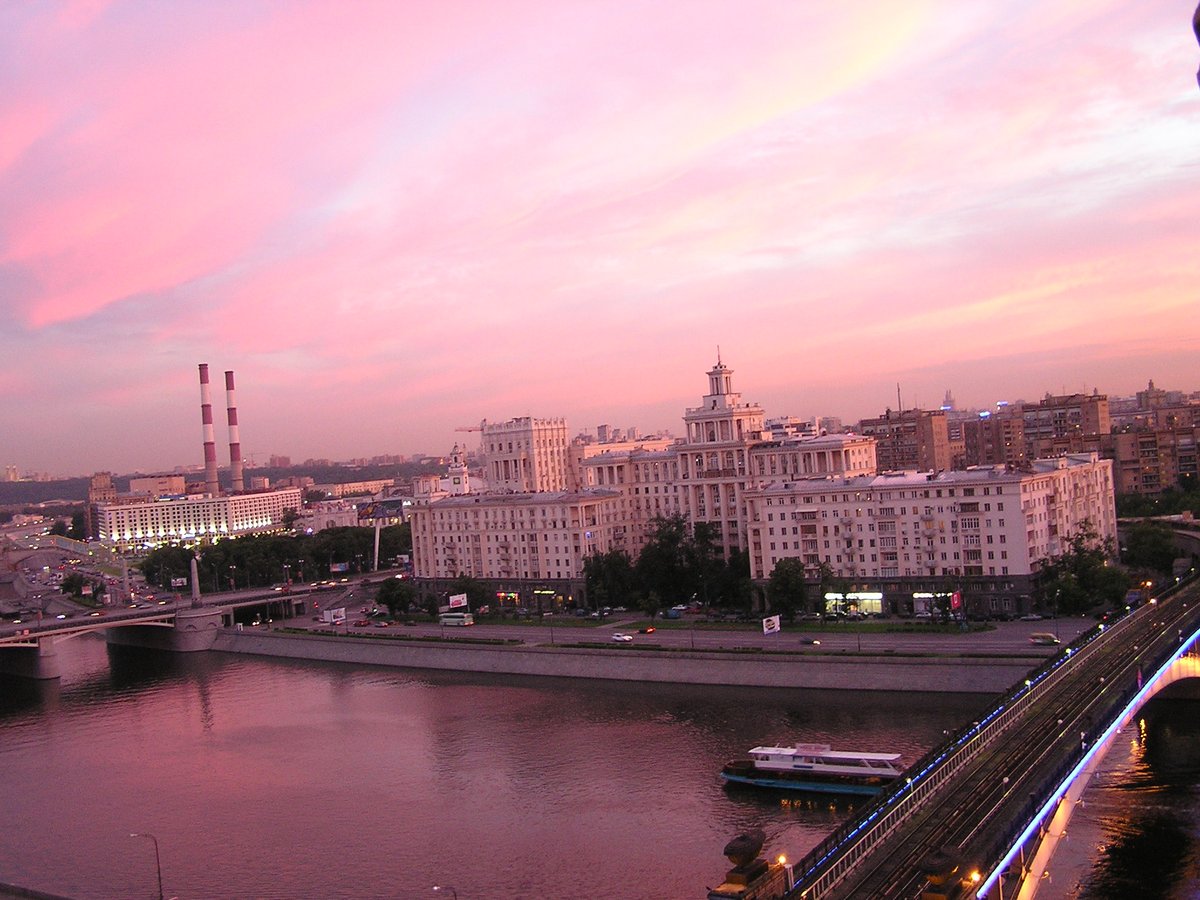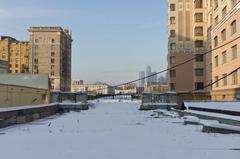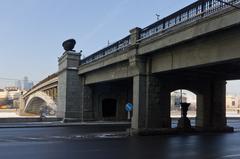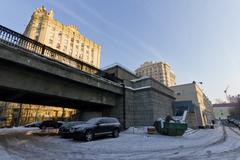
Smolensky Metro Bridge Visiting Hours, Tickets, and Guide to Moscow’s Historic Metro Landmark
Date: 15/06/2025
Introduction
The Smolensky Metro Bridge (Смоленский метромост) stands as a testament to Moscow’s bold urban ambitions and Soviet engineering prowess. Completed in 1937, this iconic structure was the first bridge built specifically for the Moscow Metro, allowing metro lines to cross the Moskva River and connect the city’s heart with its expanding western districts. Blending functionality, historical significance, and understated architectural appeal, the bridge remains a vital artery in the Filyovskaya Line and a silent witness to Moscow’s transformation into a modern metropolis. Visitors can experience the bridge’s legacy through metro rides or from picturesque river embankments, making it a compelling highlight for those interested in Moscow’s historical sites and transport heritage (factsnippet.com, howtorussia.com, Wikipedia).
Table of Contents
- Introduction
- Historical Context and Construction
- Engineering and Architectural Features
- Role During War and Post-War Development
- Urban Significance and Cultural Context
- Visiting Smolensky Metro Bridge
- Frequently Asked Questions (FAQ)
- Visuals and Media Recommendations
- Conclusion
- References
Historical Context and Construction
The Smolensky Metro Bridge was conceived as Moscow’s industrial expansion surged in the early 1930s. Its construction was a direct response to the Central Committee’s 1931 decision to create a world-class metro system—a pivotal element in Stalin’s vision of a modern socialist capital. Built between 1935 and 1937, the bridge connected the Smolenskaya and Kievskaya stations on what is now the Filyovskaya Line, marking the first time the Moscow Metro traversed the Moskva River (factsnippet.com, howtorussia.com).
The bridge’s construction required innovative engineering to overcome the river’s width and variable flow. Soviet engineers employed deep caisson foundations and a single-span steel arch, drawing inspiration from contemporary European techniques but adapting them to Moscow’s harsh climate. Tens of thousands of workers contributed to this landmark, laboring under the urgency and collective spirit characteristic of the era (howtorussia.com).
Engineering and Architectural Features
The Smolensky Metro Bridge exemplifies the utilitarian beauty of early Soviet infrastructure. Its single-span steel arch, approximately 150 meters long, provides both strength and elegance without the need for central river supports. This design efficiently distributes the metro’s heavy loads while ensuring durability against Moscow’s severe winters (Flickr Image).
While the bridge is primarily functional, its clean lines and modernist profile harmonize with the cityscape, providing a visual counterpoint to the more ornate metro stations it connects. The bridge’s approaches seamlessly integrate with underground tunnels, maintaining smooth transitions for metro trains (The Collector).
Role During War and Post-War Development
The bridge’s completion in 1937 coincided with the rapid expansion of the Moscow Metro. During World War II, the metro system—and the Smolensky Metro Bridge—became a vital lifeline for the city, doubling as an air-raid shelter and maintaining transportation under siege (howtorussia.com). The bridge’s resilience during wartime solidified its role in Moscow’s collective memory.
After the war, the metro system saw extensive modernization and expansion, with the bridge continuing to serve as a critical cross-river link. Upgrades in train technology, electrification, and safety systems were implemented over the decades, ensuring the bridge’s ongoing reliability (Devdiscourse).
Urban Significance and Cultural Context
Strategically located in the Dorogomilovo District, the Smolensky Metro Bridge connects the historic Arbat area with the major transport hub at Kiyevsky Rail Terminal. Its presence facilitated westward urban growth and shaped commuting patterns, reinforcing the Soviet ideal of connectivity and monumental infrastructure (Wikipedia).
Beyond its practical function, the bridge is embedded in Moscow’s urban identity. Nighttime illumination and its silhouette across the river contribute to the city’s evolving aesthetic. The bridge’s proximity to vibrant neighborhoods, historical monuments, and cultural venues further enhances its role as a landmark (Russiable, Trek Zone).
Visiting Smolensky Metro Bridge
Location and Accessibility
The Smolensky Metro Bridge is not open to pedestrian traffic, but visitors can easily view it from multiple public embankments. The closest metro stations are Smolenskaya and Kievskaya (Filyovskaya Line), both well-connected to Moscow’s broader public transport system (EAA).
The Troika card system enables seamless travel across metro, buses, and trams. Both stations and surrounding areas offer amenities such as cafes, restrooms, and convenient stores.
Viewing Points and Best Times to Visit
- Smolenskaya Embankment: Offers unobstructed views of the bridge’s steel arch and passing metro trains.
- Tarasa Shevchenko Embankment: Ideal for panorama shots of the river and city skyline.
- Best Times: Late spring through early autumn provides mild weather and vibrant riverfront scenes. Early morning or late afternoon light is best for photography.
Tickets and Metro Information
No special ticket is needed to view the bridge or ride the metro across it—any valid Moscow Metro ticket or Troika card will suffice. The metro operates from approximately 5:30 AM to 1:00 AM daily.
Accessibility and Safety
Most embankments and promenades are wheelchair accessible, though some may have steps or uneven surfaces. The area is well-lit and considered safe, with regular police patrols. Standard urban precautions are advised.
Nearby Attractions
- Arbat Street: Historic pedestrian zone with shops, cafes, and street art.
- Kievskaya Rail Terminal: Architectural landmark and major transit hub.
- Moscow Planetarium: One of the world’s oldest and largest planetariums.
- Novodevichy Convent: UNESCO World Heritage Site, easily reached by metro.
- Tsoi Wall and Monuments to Brodsky and Tolstoy: Notable cultural sites within a short walk.
Travel Tips
- Use the Moscow Metro mobile app for up-to-date schedules and English-language maps.
- Visit outside peak commuter hours for a more relaxed experience.
- Carry a translation app for navigating signage and announcements.
- Combine your visit with a Moscow River cruise for unique perspectives of the bridge and city.
Frequently Asked Questions (FAQ)
Q: Can I walk on the Smolensky Metro Bridge?
A: No, pedestrian access is not permitted. The bridge is reserved exclusively for metro trains.
Q: Are there visiting hours or tickets required to see the bridge?
A: No tickets or special hours apply—the surrounding embankments are public and accessible 24/7.
Q: Is the area wheelchair accessible?
A: Most embankments are accessible, but some areas may have steps or rough pavement.
Q: Are guided tours available?
A: While there are no official tours of the bridge itself, city tours often include views of it as part of broader routes focused on Moscow’s history and architecture.
Q: Can I photograph the bridge?
A: Yes, photography is encouraged from public areas. Drone use is regulated—check local laws before flying.
Visuals and Media Recommendations
- Feature high-resolution images of the Smolensky Metro Bridge from both embankments and inside metro trains.
- Use descriptive alt tags such as “Smolensky Metro Bridge over Moskva River” and “Moscow Metro crossing river at sunset.”
- Include an interactive map highlighting the bridge’s location, nearby metro stations, and main attractions.
- Offer links to virtual tours of Smolenskaya and Kievskaya stations for immersive experiences.
Conclusion
The Smolensky Metro Bridge is a unique fusion of Soviet engineering, historical depth, and urban connectivity. While not accessible to pedestrians, its enduring role in Moscow’s transport network, striking steel arch, and proximity to key cultural sites make it a rewarding destination for history buffs, architecture enthusiasts, and curious travelers alike. Whether viewed from a riverside promenade or aboard a metro train, the bridge offers insight into Moscow’s dynamic past and present.
Maximize your visit by exploring the embankments during golden hour, combining your trip with nearby attractions like Arbat Street and Novodevichy Convent, and using the Audiala app for up-to-date guides and self-paced tours. The Smolensky Metro Bridge remains a powerful symbol of Moscow’s resilience, ambition, and enduring beauty.
References
- Smolensky Metro Bridge: A Historical Marvel and Visitor’s Guide to Moscow’s Iconic Landmark, 2025, factsnippet.com
- History of Moscow Russia Metro, 2025, howtorussia.com
- Smolensky Metro Bridge, 2025, Wikipedia
- Moscow Metro History and Beauty, 2025, The Collector
- Beneath Moscow: The Architectural Marvel of the Moscow Metro, 2025, Devdiscourse
- Smolensky Metro Bridge Moscow, 2025, Trek Zone
- Moscow Metro Russia, 2025, EAA























































































































































































































































































